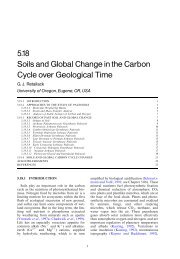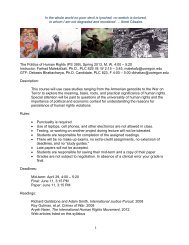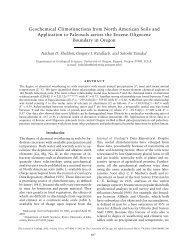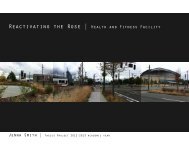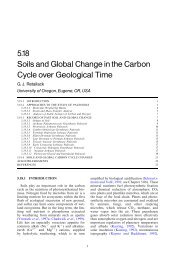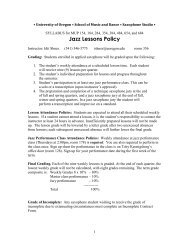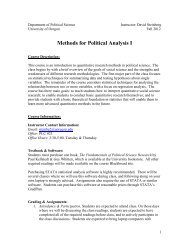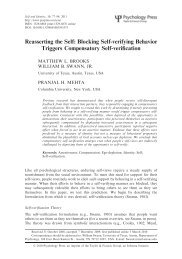drebbel's living instruments, hartmann's microcosm, and libavius's ...
drebbel's living instruments, hartmann's microcosm, and libavius's ...
drebbel's living instruments, hartmann's microcosm, and libavius's ...
You also want an ePaper? Increase the reach of your titles
YUMPU automatically turns print PDFs into web optimized ePapers that Google loves.
DREBBEL’S LIVING INSTRUMENTS · 676. Cf. J. A. Bennett, “The mechanics’ philosophy <strong>and</strong> the mechanical philosophy”, History of science,xxiv (1986), 1–27. Bennett problematized the relationship between mechanical practitioners<strong>and</strong> philosophers more in his more recent “The mechanical arts”, Early modern science, ed. byKatherine Park <strong>and</strong> Lorraine Daston (Cambridge, 2006), 673–95.7. Steven Shapin <strong>and</strong> Simon Schaffer, Leviathan <strong>and</strong> the air-pump: Hobbes, Boyle, <strong>and</strong> the experimentallife (Princeton, 1985), <strong>and</strong> Michael Mahoney, “Drawing mechanics”, in Picturing machines,1400–1700, ed. by Wolfgang Lefebvre (Cambridge, MA, 2004), 281–306.8. Tara Nummedal, Alchemy <strong>and</strong> authority in the Holy Roman empire (Chicago, 2007).9. Peter Dear, “Intelligibility in science”, Configurations, xi (2003), 157–8.10. Mary Henninger-Voss, “Working machines <strong>and</strong> noble mechanics: Guidobaldo del Monte <strong>and</strong> thetranslation of knowledge”, Isis, xci (2000), 233–59; Marcus Popplow, “Why draw picturesof machines? The social contexts of early modern machine drawings”, Picturing machines1400–1700, ed. by Lefèvre (ref. 7), 17–48; Graham Hollister Short, “The formation of knowledgeconcerning atmospheric pressure <strong>and</strong> steam power in Europe from Aleotti (1589) to Papin (1690)”,History of technology, xxv (2004), 137–50; <strong>and</strong> Pamela Smith, The body of the artisan: Art <strong>and</strong>experience in the scientific revolution (Chicago, 2004).11. Notably in Svetlana Alpers, The art of describing: Dutch art in the seventeenth century (Chicago,1983), 4–5, 12–13, 23. Pamela Smith, who noted the interpretation of On the nature of theelements as a series of alchemical receipts on the title-page of the British Library edition ofDrebbel’s works (British Library 1033.c.34), offers an important exception. See Smith, op. cit.(ref. 10), 163, where she describes the “First Tincture” of Drebbel’s Preface <strong>and</strong> the “SecondTincture” of Chapter Ten. Drebbel’s “sperma” is a “tincture taken out of the body of the earth,which must be fixed with spirit through the circle of the elements” (“Tincturam ex corporeterrae desumptam, quam cum spiritû figi debere per rotam elementis”). These descriptionscorrespond extremely well with Libavius’s interpretation (discussed below), who considered thetenth chapter the most important part (“medulla”) of the text. Andreas Libavius, “Apocalypseoshermeticae pars posterior”, Syntagma arcanorum chymicorum ... tomus secundus (Frankfurt,1613), 328–453, p. 375.12. He does not appear, for instance, in Katherine Park <strong>and</strong> Lorraine Daston (eds), The Cambridgehistory of science: Early modern science (Cambridge, 2006).13. Regionaal Archief, Alkmaar, Weeshuis 16, 360–362v. A German 1608 translation is currently thefirst extant edition. Johann Ernst Burggrav claimed that translation as his own in his prefaceto his second edition of Drebbel, Ein kurtzer tractat von der natur der elementen (Frankfurt,1628). Burggrav mentioned that Drebbel had printed a few copies earlier in Dutch to be givento a few friends <strong>and</strong> philosophers. This must have been the Dutch edition mentioned by IsaacBeeckman in 1619 in his Journal tenu par Isaac Beeckman de 1604 à 1634, ed. by Cornelis deWaard (The Hague, 1939–53), i, 346. A portrait of Drebbel dated 1604, copied in many latereditions of the work, is still extant.14. The classic biography remains F. M. Jaeger, Cornelis Drebbel en zijne tijdgenooten (Groningen,1922). For Drebbel as Chief Engineer <strong>and</strong> his death <strong>and</strong> burial in 1633, see Edward MurrayTomlinson, A history of the Minories, London (London, 1922), 136, 400.15. Beeckman, Journal tenu par Isaac Beeckman (ref. 13), i, 346; ii, 201, 202, 363, 372; iii, 203–4, 302–4,358, 367; Constantijn Hugyens, “Fragment eener autobiographie van Constantijn Huygens”, ed.by J. A. Worp, Bijdragen en mededeelingen van het historisch genootschap, xviii (1897), 1–122;Harcourt Brown, Scientific organizations in seventeenth-century France (Baltimore, 1934), 270;<strong>and</strong> Nicolas-Claude Fabri de Peiresc, Lettres de Peiresc aux frères Dupuy, ii (Paris, 1890), 68.16. Arianna Borrelli, “The weather glass <strong>and</strong> its observers in the early seventeenth century”, Philosophiesof technology: Francis Bacon <strong>and</strong> his contemporaries, ed. by Claus Zittel et al. (Leiden, 2008),67–132; on Descartes, p. 125. Ian Maclean, “Introduction”, in René Descartes, A discourse on



